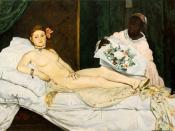A painting of a nude woman, a Negress and a cat changed the way of art, class and modernity in 1865. It was a time of ordre moral, a time when bourgeoisie and primness dominated high brow culture. Edouard Manet rebelled against this by rattling the world with his painting of Olympia. Since its unveiling, at the Salon in Paris, reactions ranging from horrified shock to scholarly criticism ignited and still persist today. T.J. Clark, an art history professor at the University of California at Berkeley, examines this painting and responds to it in his book, The Painting of Modern Life. Clark's recently revised version contains thoughts on Olympia not explored over a century ago, he offers insight sustaining the beauty that surrounds the ugliness of Olympia. Looking at other modes other than Haussmanization, Clark responds to the painting by accepting, negotiating and refuting past criticisms in efforts to assert his own.
Mostly, he rejects the earlier criticisms with the exception of supporting the review by art historian Jean Ravenel. Essentially, he boils it down to an issue of social order, class and modernity by investigating the subject of prostitution with respect to the time, the aesthetics of the painting, the category of a prostitute, the role of a courtesan, and the possible inspirations for the painting by centralizing the concept of modernity. An attempt to delineate the controversy of the painting, in accordance to Clark, will aid in understanding how magnitude of its significance in modern art.
In depicting a prostitute, Manet dealt with an issue all too prevalent yet not recognized, at least not the way Manet approached it. Prostitution had become a commonplace by the 1860's and as a result it further propelled the idea of modernity. One might argue that it did...

![Champ Clark at Sea Gert [i.e., Girt] (LOC)](https://s.writework.com/uploads/11/119189/champ-clark-sea-gert-e-girt-loc-thumb.jpg)

Presentable piece of work
Overall essay seems to have a good flow... would suggest to include ref and citation within paragraphs
3 out of 3 people found this comment useful.